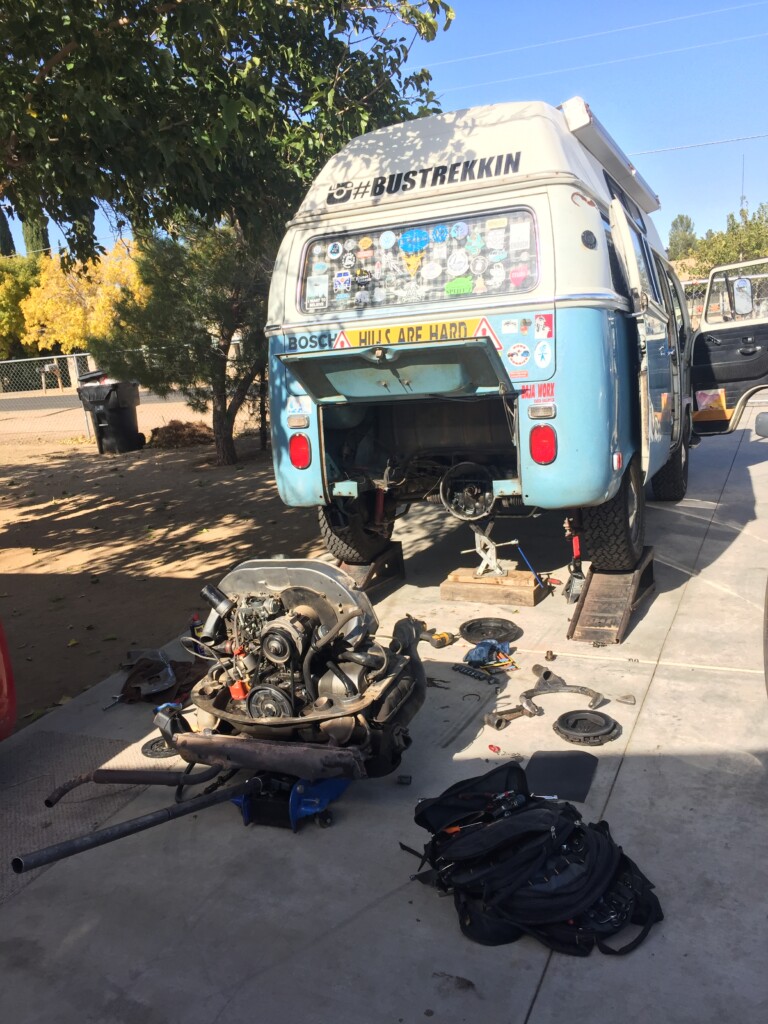When traveling the world in a VW Bus, your choice of tools and spare parts can be the difference between a quick roadside repair and a ride on the back of a tow truck. A prepared Buslifer can handle much of their own maintenance and will trust in their kit in the instance of a breakdown. Having the essential tools can get you off the side of the road and to your destination, without reaching for your wallet.
Some Buslifers do all of their own maintenance, others just do the basics and let a qualified mechanic sort out the rest. Making it to a mechanic isn’t always the final solution, especially in cases where parts are needed. Having the common consumable parts on you can be a lifesaver. Once you have made it to a mechanic, expect them to take some time to locate parts and have them delivered before the repair can be made. Finding the right part on the road can be a challenge. The right part at the right moment can save you days of hassle. Who wants to wait days or weeks for a clevis pin you could have in the glovebox? Having spare parts that commonly fail on board will keep you rolling forward.
What does an experienced Buslifer carry to keep the gremlins at bay?
Let’s break it down. Pun intended.
In this article, we are going to cover your basic tool kit and advanced tooling for more confident mechanics. We will even cover a few items outside of the toolbox to make the breakdown easier to manage. When the time comes to test your tool kit, you can hold your head high and get your hands dirty.
Essential parts
Packing extra consumable parts is a must. Start with thinking about the soft and replaceable parts. For example, O rings, seals, and gaskets are commonly replaced during normal maintenance. When traveling with a typical air-cooled engine I prefer not to leave the house without the following. Don’t find yourself on the side of the road without these must-haves in your essential tool kit.
Valve cover gaskets
These seals need to be changed with every valve adjustment, sealing the side covers and retaining your oil. The valve cover gaskets are inexpensive and extremely valuable when needed.
Oil
Sometimes the oil you need may not be easy to find, bring it with you! I use a special high zinc oil that is not available at every auto parts store, so I always keep at least a quart on hand. Most newer vehicles use oils not suited for a VW Bus. Keep a full change onboard if you have the space for it.
Oil change kit
Always have the ability to change your oil. It’s smart to have the sump gaskets and copper tucked away with your oil.
Points and condenser
Even though I have an electronic ignition upgrade, they do fail from time to time. Keeping a spare set of points and a condenser allows me to convert back to a mechanical ignition if needed. For those of you running classic points, you never know when they will fail. Make sure you have a spare set.
Fan belt
On all air-cooled VW Buses, your belt runs the fan that cools your engine and spools up the charging system, without it, overheating is inevitable. There are many different automotive belts out there and having the right size for a quick replacement is crucial. Too tight and it will be impossible to install correctly, too loose and it will slip, or worse yet fly off completely. When you carry the correct belt for your pulley system, you can literally keep it cool.
Spark plugs
Plug fouled? No problem, you brought more. When changing a plug remember to ALWAYS add a thread lubricant product like anti-seize to your spark plugs. You cannot change a plug if you cannot remove it. A little dab on the threads is all you need.
Throttle cable
This is the most common failure I have experienced in 20+ years of operating a VW Bus. I carry two spares, one for me and one to help another Buslifer if needed.
Clutch cable
There is nothing more frustrating than a clutch cable failure. Trying to find a replacement on the road can be very challenging. Clutch cables are difficult to find in the USA outside a VW specialty shop, so keep one on hand.
Clutch cable clevis pin
Sometimes what feels like a clutch cable failure is just a failed clevis pin. It is common for them to wear completely through the pin itself! Having this tiny part will save your day.
Fuel filter
I keep about 3 of these in my kit at all times. They are cheap and easy to pack away.
Black RTV silicone
Silicone sealant can be a lifesaver when chasing down pesky leaks.
Basic tools
The basics are pretty simple. Volkswagen included a basic tool kit with most models. Small, simple, and discrete.
- Flat head screwdrivers, one large one small
- Crosshead screwdriver
- Adjustable pliers
- Spark plug wrench
- Open end wrenches
- 8mm, 10mm, 11mm, 13mm, 15mm, 17mm, and 19mm
- Lug nut wrench
- Jack
These tools can handle most of the simple operations needed for general maintenance. This kit is great to have separated from your main tools for ease of access. I store the basics under my seat or tucked away in the glove compartment. Break down in the rain? Grab the small kit and get it fixed instead of pulling out the full spread.
When you hear the dreaded clunk, screech, or snap that the small kit will not handle, it is time to reach for the full set of tools. Let’s go over some of the advanced tools you will need to be packed to solve any mishap on the road.



Advanced tooling to handle any situation
Timing light
To me, the timing light is a must-have piece of equipment when traveling in an air-cooled VW Bus. Your timing is critical. Too advanced, you can destroy your engine, too retarded, you will lose power. Every time you interact with your distributor you will need to verify your ignition timing. Most air-cooled engines like to be timed at 30° at 3000 rpm. Too much advance will fire too early. This is the equivalent of hitting your piston with a hammer. Incorrect timing can do some major damage over time. The quickest way to verify that timing is correct is with a timing light.
Get it: Timing light
Test light
A test light can make quick work of diagnosing electrical troubles. For example, a parasitic drain on the battery can be an intimidating puzzle for the average Buslifer to solve. Let’s say you have a power drain causing problems. You can disconnect the negative terminal on the battery, and place the test light between the negative post on the battery and a grounding point. If the light comes on when the ignition is turned off, there is a short somewhere, draining the battery. To quickly find the shorted circuit, simply remove fuses from the fuse box until the test light goes out. Bingo. You found the circuit with the short, inspect it, and repair it. A test light is a very valuable tool to have on hand and can shed light on the darkest of wiring mishaps.
Get it: Test light
Vice grips
The ability to clamp and hold something with force is what this tool is made for. I find it specifically useful when changing out a clutch cable. You know this if you have ever tried removing the wingnut from the clutch cable without one. Clamping the cable prevents it from spinning while removing the wingnut. This will make adjustment so much easier for yourself and anyone within an earshot of the curses you would have shouted without it.
A pair of vice grips can also be used as a fuel line clamp when working on anything to do with the fuel system. Clamping the fuel line just below the tank can give you peace of mind while working on something simple as a carburetor or as involved as engine removal.
Get it: Vice grips
Feeler gauge set
The feeler gauges are primarily used to check your valve gap. Later model buses do not require the same valve adjustment as their predecessors, but may still need to be checked with a feeler gauge from time to time. Knowing the procedure for setting valves on any air-cooled engine is a good skill to have. The knowledge is out there and I advise getting familiar with it. Sometimes the best tool you have is the practice you’ve already done.
Get it: Feeler gauge set
Torque wrench
There are a few different torque wrenches out there. If you are doing anything beyond basic maintenance you should own one. I carry a small digital torque wrench adapter made by ACDelco. It fits a basic ⅜ drive wrench. Place it between any socket and wrench and you have a torque wrench at your disposal. Things like rockers, heads, cv joint hardware, lug nuts, etc require a specific torque to safely function. Having one in your kit is critical.
Get it: Acdelco Torque wrench adapter
Torque leverage tool
The Torque Leverage Tool, has only one function on a bus, removing the gland nut from the flywheel on both 6-volt and 12-volt models. The gland nut requires a whopping 235 ft-lbs of torque. Most torque wrenches do not have the range or the strength needed. That nut secures the flywheel to the crank, and the pesky main seal is right behind it. This seal can be very intimidating to get to, but this tool makes the operation quick and easy. The tool multiplies torque, one end slides over your gland nut, the other end has a small cog that fits in the teeth around the flywheel. 25 ft-lbs on a torque wrench becomes 235 ft-lbs at the gland nut. This allows you to easily remove or install the gland nut with a standard torque wrench.
Get it: Torque leverage tool
Battery powered impact driver
Having a little electric assistance can shave a lot of time off disassembly. When combined with a ⅜ drive adapter it becomes a speed wrench. I do not recommend installing hardware with this tool, when it snugs up it can break the hardware. A standard upright air-cooled engine can be removed in minutes with the help of an impact driver. When using a 12” socket extension you can reach three of the 17mm fasteners holding the engine to the transaxle. I recommend having a 17mm ratcheting box-end wrench for that last nut behind the fan shroud. Getting that one out without a low-profile ratchet can be a frustrating task. A ratcheting 17mm wrench has the low profile needed to easily reach that nut. On upright cooling models, you have to do it by feel as it’s hidden behind the fan shroud.
Get it: Impact driver, socket adapter, 17mm ratcheting wrench
Tool storage
Ok, you’ve gathered the tools, where do they go? After two decades of working on Volkswagens, I found a tool bag that has met my every need. It’s a tool backpack, compact, rugged, and useful. It can be tucked away with ease and can carry every tool you need in one place. The shoulder straps make it easy to carry while leaving your hands free. It can be easily tucked away, storing everything you need in one happy satchel.
Get it: CNC tool backpack
Ground control
Having a good surface to lay on can really make a huge difference in your quality of life after a repair. If you have ever pulled a twig from your hair hours after being under your VW Bus you can relate. Having a good floor cover can prevent a lot of extra clean-up and is generally more comfortable when working under your bus. This can be as simple as a piece of cardboard, a yoga mat, a small rug, etc. Giving yourself a barrier between your body and the ground makes time under the bus more enjoyable. Many of these mats can double for other uses in a pinch.
Get it: Ground mat
Coveralls
If getting dirty is inevitable, staying clean can be difficult through many repairs. Coveralls are a barrier, protecting you and your outfit. When you are done with your repair, you can peel off the filth and venture on clean and happy. Cold night around a campfire? Coveralls can double as an easy way to keep warm. Throw one on over your clothes and you will retain body heat and stay toasty. I prefer the thin coveralls for mobility and my climate, but Buslifer’s in colder areas of the world may prefer something more robust.
Get it: Dickies coveralls
Straps and bungies
Ratchet straps are useful for more than just tying things down. Ever had to change out a clutch cable? If you hook the clutch lever to the body with a ratchet strap, you can thread the wingnut onto the cable with ease, leaving battles with the clutch arm spring in the past. No bloody knuckles, no pinched fingers. Work smarter, not harder.
Get it: Ratchet straps
Jump pack/air compressor combo
Modern jump packs are fantastic. Most jump packs can start your car and charge your phone with ease. The added utility of the air compressor is a lifesaver after you have plugged your own tire.
Get it: Jump pack compressor combo
Where the rubber meets the road
When that telltale hissing starts you know you’ve punctured a tire. You don’t have to jump on the spare tire just yet. Learning how to use a vulcanizing rubber tire repair kit can have you back on the road without ever needing to pull out the jack. These kits are inexpensive and very useful, especially for those of us who leave the pavement every chance we have. Plug, inflate, roll on.
Get it: Tire repair kit
Quick fix supplies
Every once in a while something small and silly might have you on the side of the road. Things like a broken carb spring, missing hardware, or a cracked intake boot can be patched on the side of the road with some of these good emergency supplies. If you find yourself in a situation, here is what you might need:
- Zip ties
- Bailing wire
- Electrical tape
- Rubber bands
- Jb weld putty
Rest and relaxation
You’ve made it through your breakdown and arrived at your destination. You deserve to kick your feet up and relax. A hammock has always been a part of my onboard kit. There have been many times where a well-placed tree, sign, or parking meter has served as my second anchor point using the bus as the first. At the end of a long day, sit back, relax, and enjoy life as a Buslifer.
Get it: Hammock
Uh oh
The last item on the list is a quality tow strap or nylon webbing. Jokes aside, you may have done everything you could to solve the problem. Sometimes, when all else fails, the way onward is with the new friend you just flagged to drag you down the road.
Get it: Tow strap
This concludes our list of Essential Tools for a Buslifer. Following these tips will keep you prepared for most roadside issues on the blacktop or in the dirt. Now go out and fill the voids in your tooling. Of course, tools and parts aren’t the only things you need to prepare before setting off on an adventure. Check out our article, Preparing Your Vehicle for the Road, for even more great information.



[…] Quote from the source: … […]
[…] Screwdriver Set Tuning Carburetor […]